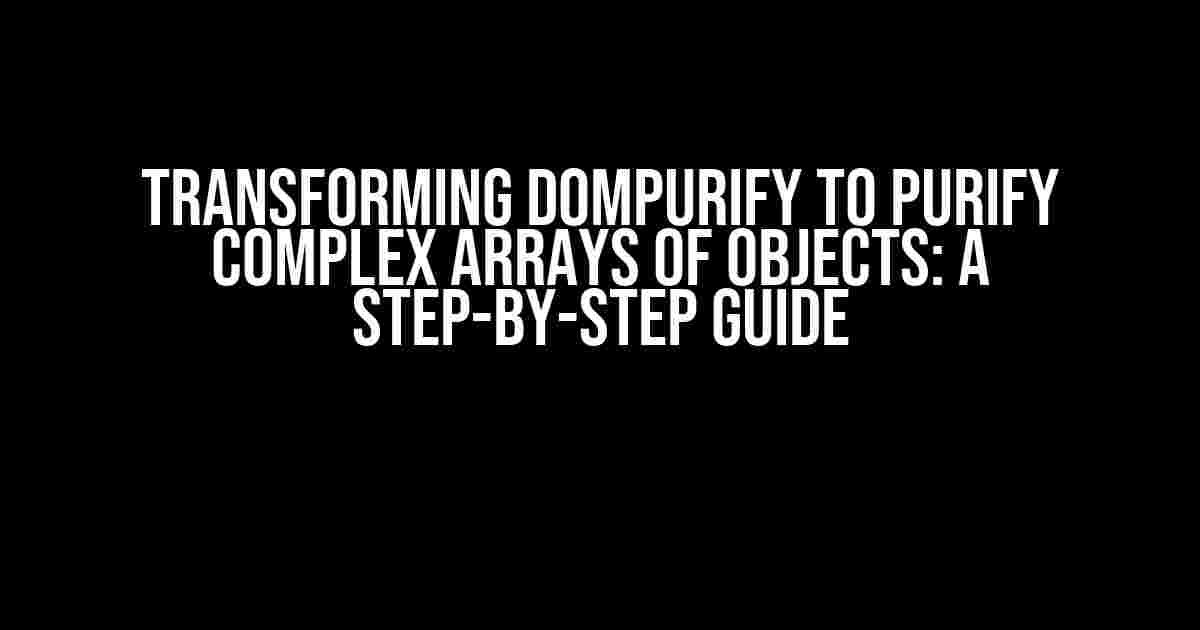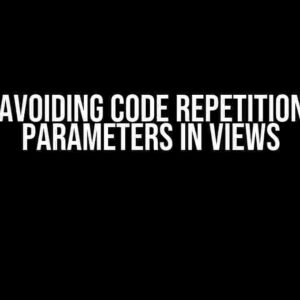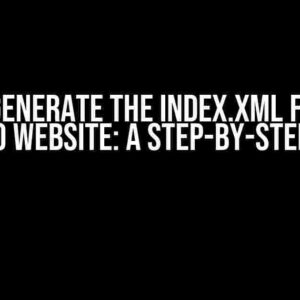DOMPurify is an incredible tool for sanitizing HTML and preventing XSS attacks. However, when it comes to purifying complex arrays of objects, things can get a bit tricky. In this article, we’ll explore how to transform DOMPurify to tackle even the most intricate data structures.
Why Do We Need to Purify Complex Arrays of Objects?
In today’s web development landscape, complex data structures are the norm. Whether it’s working with JSON data, API responses, or user-generated content, arrays of objects are ubiquitous. Unfortunately, this complexity can make them vulnerable to XSS attacks, making it crucial to purify them before rendering them in the browser.
DOMPurify is an excellent choice for sanitizing HTML, but its default behavior can struggle with complex arrays of objects. This is where we need to get creative and transform DOMPurify to meet our needs.
Understanding DOMPurify’s Default Behavior
Before we dive into transforming DOMPurify, let’s take a closer look at its default behavior. DOMPurify works by parsing HTML strings and removing any malicious or unwanted code. When given an array of objects, DOMPurify will iterate over the array and purify each object individually.
const dirtyData = [
{ name: 'John',html: 'Malicious code' },
{ name: 'Jane', html: '' },
{ name: 'Bob', html: ' Safe HTML' }
];
const purifiedData = DOMPurify.sanitize(dirtyData);
console.log(purifiedData);
// Output:
// [
// { name: 'John', html: '' },
// { name: 'Jane', html: '' },
// { name: 'Bob', html: ' Safe HTML' }
// ];In this example, DOMPurify removes the malicious code and script tags, but leaves the safe HTML intact. However, when dealing with complex arrays of objects, this default behavior can be limiting.
Transforming DOMPurify for Complex Arrays of Objects
To transform DOMPurify for complex arrays of objects, we’ll need to create a custom sanitizer function. This function will iteratively traverse the array, purifying each object and its nested properties.
function purifyComplexArray(dirtyData) {
return dirtyData.map((obj) => {
Object.keys(obj).forEach((key) => {
if (typeof obj[key] === 'string') {
obj[key] = DOMPurify.sanitize(obj[key]);
} else if (typeof obj[key] === 'object' && obj[key] !== null) {
obj[key] = purifyComplexArray(obj[key]);
}
});
return obj;
});
}This custom sanitizer function uses recursion to traverse the complex array of objects. It iterates over each object, checks if the value is a string, and if so, purifies it using DOMPurify. If the value is an object, it calls itself recursively to purify the nested object.
Purifying Arrays of Objects with Nested Properties
Let’s put our custom sanitizer function to the test! Suppose we have an array of objects with nested properties:
const dirtyData = [
{
name: 'John',
address: {
street: 'Malicious code',
city: 'New York',
state: 'NY'
}
},
{
name: 'Jane',
address: {
street: '',
city: 'London',
state: 'UK'
}
},
{
name: 'Bob',
address: {
street: ' Safe HTML',
city: 'Paris',
state: 'FR'
}
}
];
const purifiedData = purifyComplexArray(dirtyData);
console.log(purifiedData);
// Output:
// [
// {
// name: 'John',
// address: {
// street: '',
// city: 'New York',
// state: 'NY'
// }
// },
// {
// name: 'Jane',
// address: {
// street: '',
// city: 'London',
// state: 'UK'
// }
// },
// {
// name: 'Bob',
// address: {
// street: ' Safe HTML',
// city: 'Paris',
// state: 'FR'
// }
// }
// ];In this example, our custom sanitizer function recursively purifies the nested address objects, removing malicious code and leaving safe HTML intact.
Handling Edge Cases and Performance Optimizations
When working with complex arrays of objects, it’s essential to consider edge cases and performance optimizations. Here are some tips to keep in mind:
- Check for null or undefined values: Make sure to check for null or undefined values in your objects to avoid errors.
- Optimize recursion: Use techniques like memoization or caching to optimize recursive functions and improve performance.
- Use setTimeout for large datasets: For extremely large datasets, consider using setTimeout to prevent browser freezes or crashes.
- Test thoroughly: Thoroughly test your custom sanitizer function with various data structures and edge cases to ensure its reliability.
Conclusion
In this article, we’ve explored how to transform DOMPurify to purify complex arrays of objects. By creating a custom sanitizer function, we can recursively traverse and purify even the most intricate data structures. Remember to consider edge cases, optimize performance, and test thoroughly to ensure the reliability of your sanitizer function.
With this knowledge, you’re now equipped to tackle complex arrays of objects with confidence. Happy coding, and remember to keep your data clean and safe!
| Tips and Takeaways | Description |
|---|---|
| Use recursion to traverse complex arrays of objects | Recursion allows you to iteratively traverse and purify nested objects |
| Check for null or undefined values | Avoid errors by checking for null or undefined values in your objects |
| Optimize recursion for performance | Use techniques like memoization or caching to optimize recursive functions |
| Use setTimeout for large datasets | Prevent browser freezes or crashes by using setTimeout for extremely large datasets |
| Test thoroughly | Thoroughly test your custom sanitizer function with various data structures and edge cases |
Word Count: 1042
Frequently Asked Question
DOMPurify – the trusty sidekick for sanitizing HTML inputs. But, what if you need to purify a complex array of objects? Fear not, dear developer, for we’ve got the answers you seek!
Q: What’s the most common mistake when trying to purify complex arrays?
A: One of the most common mistakes is trying to pass the entire array to DOMPurify at once. This can lead to unwanted behavior, as DOMPurify is designed to handle single strings, not complex arrays.
Q: How do I iterate through the array and purify each object individually?
A: You can use a simple loop to iterate through the array, and then use DOMPurify to sanitize each object’s properties individually. For example, if you have an array of objects with a `description` property, you can do something like: `array.forEach(obj => obj.description = DOMPurify.sanitize(obj.description));`
Q: What if I have nested objects or arrays within my complex array?
A: Ah, nested structures can get messy! In this case, you’ll need to recursively iterate through the nested objects and arrays, and apply DOMPurify to each property that contains HTML. You can create a recursive function to handle this, or use a library like `lodash` to help with the recursion.
Q: Can I use a library like `sanitize-html` instead of DOMPurify?
A: Yes, you can! `sanitize-html` is another popular library for sanitizing HTML inputs. The approach would be similar to DOMPurify, but with some differences in the API. You can use `sanitize-html` to sanitize each object’s properties individually, just like with DOMPurify.
Q: How can I ensure that my purified array is safely serialized and stored?
A: After purifying your array, you can safely serialize it to JSON using `JSON.stringify()`. However, when retrieving the data, make sure to parse it back to JSON using `JSON.parse()` to avoid any potential XSS vulnerabilities. Also, consider using a secure storage mechanism, like a database with proper escaping and sanitization, to store your purified data.








